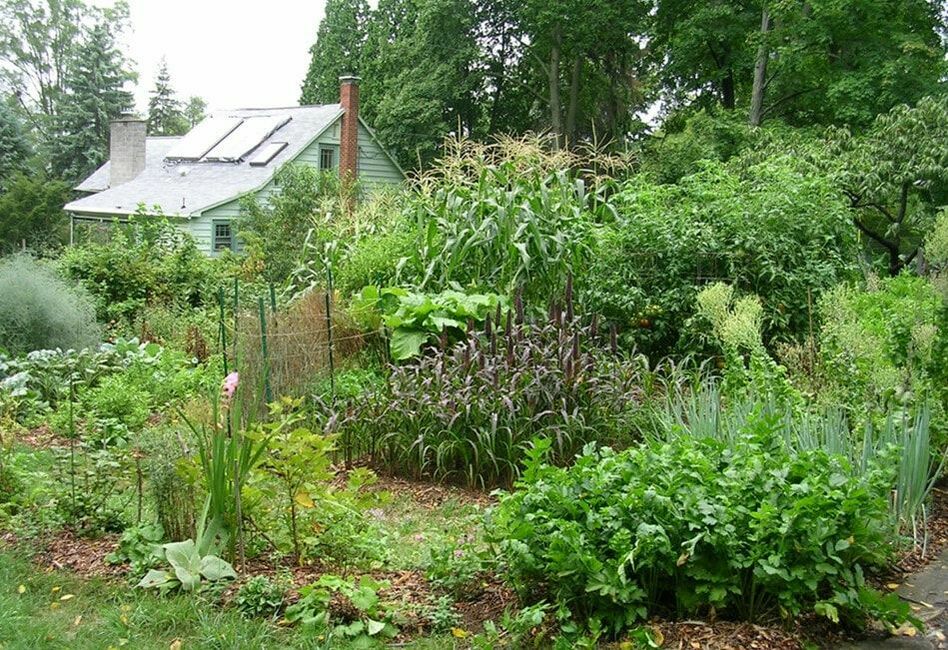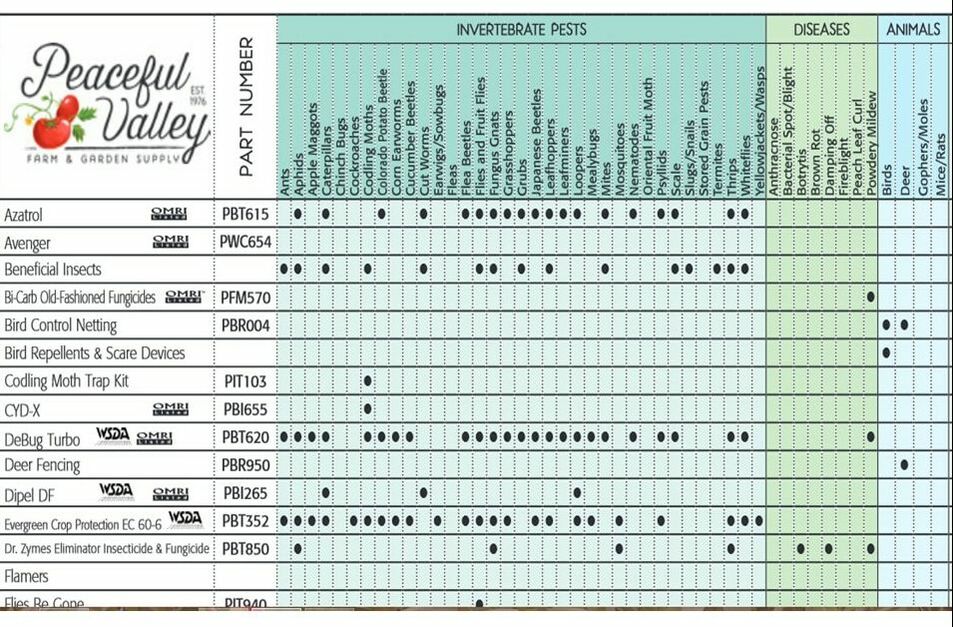Above: Wheel bug nymph in our asparagus patch
Pests & Diseases In Your Garden And What To Do About These
|
Nothing focuses our attention as much as something amiss in our garden. Everything is fine one day, and then on another we find all the still green peaches gone, a gray fuzz underneath our tomato leaves, our ripening elderberry clusters wilted, a large hole in the center of our trampled carrot patch, corn tassels a matted mess, our initially vibrant beet seedlings stunted and droopy. What is going on? (Answers bottom of page)
On this page we provide answers in three ways: (1) Quick references, (2) Solutions we have used for specific pests and diseases in our garden; and (3) Our spray schedule for pests and diseases. . |
Mid-summer at Neo-Terra
|
Quick References
1. Dynamite Chart. Peaceful Valley Farm and Garden Supply has a particularly good chart on organic methods for controlling pests and diseases. (www.groworganic.com). Under “All Categories” in the menu bar click on “Weed and Pest Control”. For 2019 this expanded page showed a “Pest Control Solution Guide” which you can download for detailed study (portion shown below).
2. The Best Bug Guide. Get Whitney Cranshaw’s indispensable Garden Insects of North America. Color images for eggs, nymphs, adults plus thumbnail descriptions of habitats, feeding behaviors, reproduction, etc.
3. Excellent Diagnostic Guide. Modeled on good mushroom guides, Deardorff and Wadsworth’s What’s Wrong With My Plant (And How Do I Fix It?) will get you out of many a tight spot, and quickly.
4. Oldie But Goodie. For identifying diseases of common vegetables, the most useful and handy short publication with full color photos and a spiral lay-flat binding is Identifying Diseases of Vegetables by MacNab, Sherf, and Springer, professors respectively from Penn State, Cornell and Rutgers. A bargain at $13 (https://extension.psu.edu/identifying-diseases-of-vegetables).
5. Tools. A good magnifier for the traditionalist. Tania takes photos with her digital camera and then enlarges these to see what’s going on. Great for investigating diseases and identifying bugs after these have flown off.
6. Suppliers Mentioned. Peaceful Valley Farm and Garden Supply, Fedco, and Gardens Alive.
Solutions for Pests and Diseases in Our Garden (downloadable here)
In this pdf we cover four categories of defenses: (1) barriers, (2) traps, (3) bio-controls and (4) chemicals for both pests and diseases. (download here)
Spray Schedule for Pests and Diseases (downloadable here)
Sprays are a common and widespread remedy for pests and diseases. These require proper identification, repeated applications, careful timing, and one or more sprayers. After years of trial and error, we have worked out a spray schedule that works for us. Feel free to adapt to your own use. Downloadable here.
Bug Mug Shots
Coming later.
Answers to scenarios in opening paragraph: bear, late blight, elder borer, groundhog, black aphids, boron deficiency
1. Dynamite Chart. Peaceful Valley Farm and Garden Supply has a particularly good chart on organic methods for controlling pests and diseases. (www.groworganic.com). Under “All Categories” in the menu bar click on “Weed and Pest Control”. For 2019 this expanded page showed a “Pest Control Solution Guide” which you can download for detailed study (portion shown below).
2. The Best Bug Guide. Get Whitney Cranshaw’s indispensable Garden Insects of North America. Color images for eggs, nymphs, adults plus thumbnail descriptions of habitats, feeding behaviors, reproduction, etc.
3. Excellent Diagnostic Guide. Modeled on good mushroom guides, Deardorff and Wadsworth’s What’s Wrong With My Plant (And How Do I Fix It?) will get you out of many a tight spot, and quickly.
4. Oldie But Goodie. For identifying diseases of common vegetables, the most useful and handy short publication with full color photos and a spiral lay-flat binding is Identifying Diseases of Vegetables by MacNab, Sherf, and Springer, professors respectively from Penn State, Cornell and Rutgers. A bargain at $13 (https://extension.psu.edu/identifying-diseases-of-vegetables).
5. Tools. A good magnifier for the traditionalist. Tania takes photos with her digital camera and then enlarges these to see what’s going on. Great for investigating diseases and identifying bugs after these have flown off.
6. Suppliers Mentioned. Peaceful Valley Farm and Garden Supply, Fedco, and Gardens Alive.
Solutions for Pests and Diseases in Our Garden (downloadable here)
In this pdf we cover four categories of defenses: (1) barriers, (2) traps, (3) bio-controls and (4) chemicals for both pests and diseases. (download here)
Spray Schedule for Pests and Diseases (downloadable here)
Sprays are a common and widespread remedy for pests and diseases. These require proper identification, repeated applications, careful timing, and one or more sprayers. After years of trial and error, we have worked out a spray schedule that works for us. Feel free to adapt to your own use. Downloadable here.
Bug Mug Shots
Coming later.
Answers to scenarios in opening paragraph: bear, late blight, elder borer, groundhog, black aphids, boron deficiency


